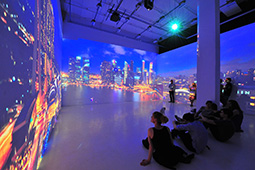July 2022
- English
- 日本語
Lighting Design for the City and Its People

The water basin at the Nagasaki National Peace Memorial Hall for the Atomic Bomb Victims, with lighting designed by Lighting Planners Associates (2003) 
Gardens by the Bay in Singapore with “organic lighting” design by Lighting Planners Associates (2012)

Mende Kaoru, Principal of Lighting Planners Associates 
A vision of the future of city lighting created for Nightscape 2050 – A Dialogue between Cities-Light-People in Future (2015)

Mende Kaoru is an award-winning architectural lighting designer known for his wide range of activities from residential and architectural to urban and environmental lighting design. We asked Mende about his work.

The term “lighting design” generally refers to the work of arranging a space using lights, but the work can involve a great many things. This includes not only design of lighting of rooms and buildings, but also the design of lighting related to the wider urban environment.
Mainstream lighting is shifting away from the use of light bulbs and fluorescent lights toward LEDs and laser light sources. In 2015, Mende Kaoru, a famous Japanese lighting designer, hosted the traveling exhibition “Nightscape 2050 – A Dialogue between Cities-Light-People in Future,” exploring what lighting might look like further into the future in the context of energy consumption and people’s interactions with light.

Mende says, “When the lighting changes, the mood of the space is transformed. For example, lighting can make a person’s facial expressions appear more lively, it can make food on a table look more delicious, and it can make a cityscape look more fashionable. Of course, the opposite is also true, and so I think the most important thing in my job is to make people happy through planning out lighting.”
In 1990, Mende founded Lighting Planners Associates, a company handling a wide range of work focused on architectural lighting design, and has led lighting projects all over the world. Some of the buildings he has worked on are landmarks in their respective cities, such as Tokyo International Forum, Tokyo Station Marunouchi Building, and Gardens by the Bay in Singapore.
At Gardens by the Bay, which opened in 2012, Mende brought about new potential for the botanical gardens, previously mainly a daytime destination, by attracting many people at night with installations that used light as a form of entertainment.

Mende says that the Nagasaki National Peace Memorial Hall for the Atomic Bomb Victims, which was completed in 2003, is one lighting design that stands out in his memory in particular.
“Kuryu Akira, the man who designed this building, planned a black granite water basin 29 meters in diameter around the building to remember the atomic bomb victims who died thirsty for water. I planted 70,000 light fiber particles on the bottom of the basin, one for each person who had died in the atomic bombing. And when we went to actually light up the lights, something unexpected occurred. The surface of the water rippled as the wind blew and the lights swayed gently. A beauty greatly beyond my expectations was born.”
The Peace Memorial Hall with its softly illuminated water basin can be seen as an expression of prayers for those who died.
The appearance of a city can change through the use of light, and the emotions of the people living there may also be affected by the types of lighting used. Mende continues to search for ways to move and excite people with his lighting plans and designs.

